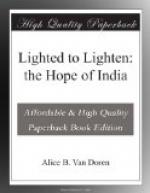After that came an end. Everywhere the Muhammadan conqueror desired many wives; in a far and alien land his own womankind were few. Again and again the ordinary Hindu householder, lacking the desperate courage of the Rajput, stood by helpless, like the Armenian of to-day, while his wife and daughter were carried off from before his eyes, to increase the harem of his ruler. Small wonder that seclusion became the order of the day—a woman would better spend her life behind the purdah of her own home than be added to the zenana of her conqueror. Later when the throes of conquest were over and Hindu women once more ventured forth to a wedding or a festival, small wonder that they copied the manners of their masters, and to escape familiarity and insult became as like as possible to women of the conquering race. Thus the use of the veil began.
At that beginning we do not wonder; what makes us marvel is that a repressing custom became so strong that, even after a century and a half of British rule, all over North India and among some conservative families of the South seclusion and the veil still persist. Walk the streets of a great commercial town like Calcutta, and you find it a city of men. An occasional Parsee lady, now and then an Indian Christian, here and there women of the cooly class whose lowly station has saved their freedom—otherwise womankind seems not to exist.
The high hour of Indian womanhood had passed, not to return until brought back by the power of Christ, in whose kingdom there is “neither male nor female, but all are one.” Yet as the afterglow flames up with a transient glory after the swift sunset, so in the gathering darkness of Muhammadan domination we see the brightness of two remarkable women.
There was Nur Jahan, the “Light of the World,” wife of the dissolute Jahangir. Never forgetful, it would seem, of a childish adventure when the little Nur Jahan in temper and pride set free his two pet doves, twenty years later the Mughal Emperor won her from her soldier husband by those same swift methods that David employed to gain the wife of Uriah, the Hittite.
And when Nur Jahan became queen she was ruler indeed, “the one overmastering influence in his life."[8] From that time on we see her, restraining her husband from his self-indulgent habits, improving his administration, crossing flooded rivers and leading attacks on elephants to save him from captivity; “a beautiful queen, beautifully dressed, clever beyond compare, contriving and scheming, plotting, planning, shielding and saving, doing all things for the man hidden in the pampered, drink-sodden carcass of the king; the man who, for her at any rate, always had a heart.” Think of Nur Jahan’s descendants, hidden in the zenanas of India. When their powers, age-repressed, are set free by Christian education, what will it mean for the future of their nation?
[Illustration: Meenachi of Madura The Average Girl, a Bride at Twelve]




